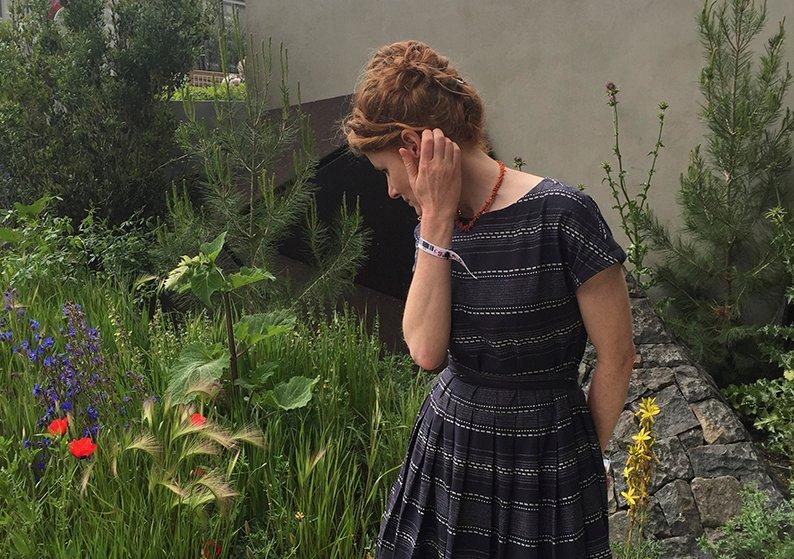
Last week I spent a glorious afternoon chasing bees over thick heads of alliums, into the ice blue caves of iris flowers or head down buried into Lychnis. I found one of the largest bees in Europe, the violet carpenter bee with wings that flash an iridescent dark violet colour, a body as black as jet, a gentle bee for its size that happily climbed onto my hand and basked in the sun whilst I'd admired those amazing wings. I hadn't come to chase bees I got distracted. I was there to admire a garden. I'd come to Villa Emo in the Veneto region of Italy. It was the perfect pre Chelsea jaunt.
The Contessa started her garden with her mother back in the seventies from a bare flat field that surrounds her very handsome 16th century villa. The garden is all sorts of clever nods to the history of Italian garden with a shameless scattering of English country garden. It is good, even better if the Contessa is taking you around, with her dry sense of humour. The spring colour scheme of her garden was decidedly old fashioned and seamlessly married to the joyous frescoes inside the villa. The over riding theme of her spring borders was peach and purple. Peach roses and hues of lilac flowers punctuated by darker purples of alliums here and there.
Orange, whether it is a blushing peach or a burnt sienna, is not an easy colour in the garden. Not in spring when the light can go from soft and dappled to searing in a day. It worked for the contessa because is suited her personality, like her beautiful old cashmere sweater it was effortless because she was and I liked it because she did. I did not feel this way when I was greeted with the many peach and pina colada sunsets at Chelsea. There were some decidedly too blousy and slightly regressive, they reminded me of gardens from the late eighties.
There were stronger oranges this year too. Nick Bailey the curator of Chelsea Physic Gardens, in his garden based around mathematics, had a lovely burnt copper Iris that was hard not to admire and it worked well with the orange hue of the bark of Stewartia, a deciduous camellia. Likewise Andy Sturgeon had some wonderful Mediterranean oranges, but my gut feeling is that orange works better later on in the year. These are colours for hot, dry gardens and climate change is not going to give us those.
When not distracted by the orange trend the rest of Chelsea falls into several categories: the faintly bonkers (a lovely Japanese garden that celebrated all that is small including a vintage Mini car), the utterly bonkers (Diarmuid Gavin's revolving topiary) and the sublime. The sublime gardens all appeared to have taken note from Dan Pearson. Similarly to his garden last year, rules were relaxed and there was a wilder, naturalistic approach. Rather than being forced into flower for this week, plants werecelebrated for being themselves withseed heads, spent flowers and dead leaves.
Cleve West's beautiful oaks (Quercus pubescens) stole the show for treesachingly beautiful arching stems and crinkled bark with the soft new growth of emerging leaves. Under planted with the soft hues of woodland gardens, lime greens, butter yellows, pale lilacs and the softest of pink stone. It was a very calm space, a trend that was found in a number of gardens that carefully created contemplative spaces. 'Modern life is stressful, take some time out', begged many of the main show gardens. James Basson worked his Provencal brush with more lavenders, olives and peach trees, a sort of artful abandoned farm look that will garner him many more fans. Chris Beardshaw took to the water with his linear pond and damp planting that one couldn't fault for tastefulness, though I like a little more tension in my spaces. Hugo Bugg's homage to the pine forest of Northern Jordan wins for me. (I am biased because I helped out on the garden.) To plunge into the heady scent of rue, to get up close to the lupins as the buff tailed bumblebees pollinate the blue flowers, turning them pink, is an utter privilege. I think the best Chelsea gardens are that places you could imagine visiting not just in spring, but also throughout the seasons. Basson and Bugg's gardens both achieved that.
For me the joy of Chelsea is a little like a good antique shop or a jumble sale, sorting through all that stuff to find the one or two gems. Muckdenia rosea is one of those. Cleve West used it on his garden based around his childhood in Exmoor and Bluebell Cottage Gardens Nursery highlighted it in their stand based on shade loving perennials. It has lovely delicate white flowers and handsome leaves that are glossy green now, turning a brilliant red in autumn. It's ideal for dry shade, which we all have a corner of somewhere.
Words by Alys Fowler
Alys wears TOAST Woven Stripe Dress available to shop here
Add a comment